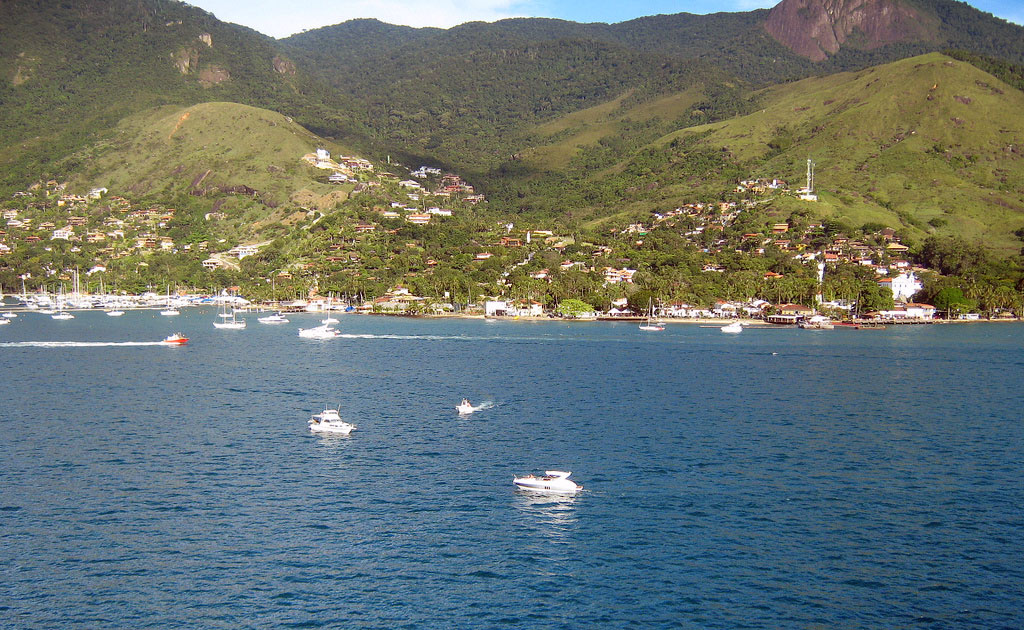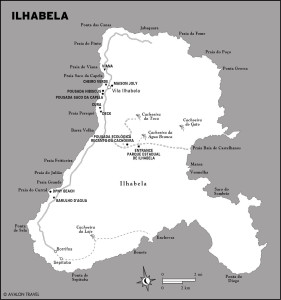
Photo © Jorge in Brazil, licensed Creative Commons Attribution.
Brazil’s largest off-coast island is only a 15-minute ferryboat ride from São Sebastião. Once you’re there, it’s utter relaxation all the way (provided you’re armed with mosquito repellent—85 percent of the volcanic island is covered in damp virgin Atlantic forest and, as a result, extremely annoying bloodsuckers called borrachudos are usually out in full force).With dozens of beaches, over 300 waterfalls, and constant breezes (which make the surrounding waters a sailor’s and windsurfer’s dream), the island is a magnet for every kind of nature enthusiast, ranging from hikers and deep-sea divers to indolent hammock-swinging Robinson Crusoe types. It also draws a fair amount of fancy folk from São Paulo—many of whom have luxurious villas tucked away on beaches, along with private piers and helicopter pads. This explains the high number of eco-chic hotels and gourmet restaurants as well as the somewhat high prices. Things get especially astronomical on holiday weekends and in January, and it gets crowded, with traffic jams on the island’s main coastal road. If you’re in search of peace and tranquility, avoid these times like the plague.

Ilhabela
The island’s main settlement is the pretty little town of Vila Ilhabela. It is located on the sheltered west coast of the island, a 20-minute drive north from the ferry dock at Perequê. Aside from a small (fairly touristy) commercial center, the town has some attractive vestiges of its colonial past, including the charming white-washed Igreja Matriz. Several kilometers before the entrance to town, on the way to the ferry, is an impressive 18th-century mansion belonging to the Fazenda Engenho d’Agua, one of the most important of Ilhabela’s many former sugar plantations. This history of cane cultivation explains the preponderance of fine cachaças on the island.
The reason that Ilhabela’s nature is so unspoiled (and its eastern coast so inaccessible) is that the majority of the island is preserved within the limits of a 270-square-kilometer (104-square-mile) natural park known as Parque Estadual de Ilhabela (tel. 12/3896-2660, 9 a.m.–4:30 p.m. daily). Whether you decide to explore the island’s treasures by sea or land (there are plenty of hiking trails and several dirt roads), in most cases you’ll need to do so with an organized excursion. Archipelagus (Av. Pedro Paulo de Morães 713, Pequéa, tel. 12/3893-1478) offers boat, Jeep, and trekking tours around the island for R$60–80. Among the most popular trips are a bumpy Jeep ride across the park to beautiful Praia de Castelhanos, trekking to Cachoeira da Laje, a spectacular waterfall near Praia do Bonete, and climbing up the Pico do Baepi, a difficult three-hour ascent that pays off with incredible views of the mountainous mainland.
Should you want to do some exploring on your own, an easy solo outing is the 3-kilometer (2-mile) hike inland from Praia de Feiticeira to Cachoeira da Toca (8 a.m.–6 p.m. daily, R$15), a waterfall with various cascades and pools as well as ropes and a zip-line course (R$10–15). Within the Parque Estadual, the Cachoeiras da Água Branca (9 a.m.–4:30 p.m. daily, free) are the only falls (there are five) you can visit on your own. Access is close to the park’s entrance.
Renting a bike is also an interesting option. An easy ride is the 4-kilometer (2.5-mile) bicycle path that runs from the Vila to Perequê. More ambitious souls can rent a more robust two-wheeler and venture the 22 kilometers (13.5 miles) to Praia de Castelhanos. Juninho Bike (Av. Princesa Isabel 217, Perequê, tel. 12/3896-2847) rents simple bikes (R$7 per hour) for short jaunts and 27-speed models (R$50 per day).
Ilhabela boasts a fantastic array of water sports. Due to the winds that blow off the northern tip, the island is considered one of the best places for sailing along the Brazilian coast. In July, it hosts Latin America’s most prestigious sailing regatta, the Semana Internacional da Vela. If you want to take sailing lessons, or rent a sailboat or kayak, contact BL3 (Av. Pedro de Paula Moraes 1166, tel. 12/3896-5885). Aside from renting sailboats (R$120–140 for 5 hours), you can rent kayaks (R$30 for 2 hours) and other small vessels. Private sailing, windsurfing, and kite surfing lessons are also offered at hourly rates ranging R$150–190.
With its crystalline waters, particularly off the east coast, Ilhabela boasts excellent diving and snorkeling opportunities. Beginners can get their feet wet at the Reserva Marinha da Ilha das Cabras, an island off of Perequê, where you can view coral, anemones, and a parade of colorful fish. Another underwater adventure is exploring the handful of sunken ships. Colonial Diver (Av. Brasil 1751, Pedra Miúdas, tel. 12/3894-9459) offers diving lessons and excursions and rents equipment. A two-hour dive for beginners costs R$220.
Ilhabela is one of the most expensive places to stay along the Litoral Norte, especially in the summer (when reservations are essential and minimum stays are required). Although stylish eco-chic guesthouses are a dime a dozen, budget bungalows are harder to come by. The vast majority of lodgings are in Vila Ilhabela, but there are an increasing number of options along the entire western coast of the island. Of good value in Vila is the charming Pousada dos Hibiscos (Av. Pedro de Paula Moraes 720, tel. 12/3896-1375, R$155–215 d), whose jungly internal courtyard features a bar, pool, sauna, and bursts of flowers. Guest rooms are standard but pleasant whitewashed affairs with dark wood furniture, tile floors, and whirling ceiling fans.
South of Vila, off Saco da Capela beach, Pousada Saco da Capela (Rua Itapema 167, tel. 12/3896-8020, R$180–280 d) offers attractive guest rooms (the best have polished hardwood floors and private verandas) in bungalows scattered amid native vegetation. Larger suites have mezzanines, private decks, and sleep up to five. If well-equipped with bug spray, hard-core jungle enthusiasts will adore the Pousada Ecoilha (Rua Benedito Garcêz 164, Água Branca, tel. 12/3896-3098, R$110–150 d), on the edge of the Parque Estadual de Ilhabela, just off the road leading to Praia de Castelhanos. Bird calls provide a constant soundtrack while the backdrop includes views of the Pico do Baepi. A recent facelift has upped the charm of the simple guest rooms, all of which boast verandas and hammocks, and there is a nice pool for cooling off.
Ilhabela’s grooviest hotel by far is the über-boutiquey DPNY Beach (Av. José Pacheco de Nascimento 7668, Praia do Curral, tel. 12/3894-2121, R$450–990 d), on trendy Praia do Curral. Almost overly designed, the guest rooms, in various sizes, are drop-dead gorgeous with richly colored walls, zebra motifs, and mosaic tiles made by the staff. The beds are king-size, TV screens are plasma, and everybody gets an iPod (laptops are available at the bar). For some privacy, request a casa caiçara, renovated fishermens’s bungalows sheltered beneath a forest of palms. An island hot spot, the hotel’s private Hippie Chic beach club doubles as a lounge where house music plays day and night (R$80 day rates include use of the fabulous spa). The contemporary restaurant, Tróia, has one of the most inventive kitchens on the island.
It’s no exaggeration to say that Maison Joly (Rua Antônio Lisboa Alves 278, tel. 12/3896-1201, R$450–660 d) is fit for royalty. Built right into a hilltop overlooking Vila Ilhabela, this exclusive luxury guesthouse has hosted everyone from the Swedish monarchy to the Rolling Stones. With a certain Italian Riviera flavor, the individually furnished bungalows are understated yet refined and boast private verandas overlooking the sea. A classy piano bar, a “Zen” space, an Anti–Jet Lag Spa, and a romantic restaurant serving delicious Mediterranean-inspired cuisine make it difficult to venture beyond the hotel.
For splendid isolation (minus some creature comforts), head to the other side of the island (4 hours by foot or 1 hour by boat). Checking into Pousada Canto Bravo (tel. 12/3896-5111, R$130–300) gives you private access to the island’s most drop-dead gorgeous beach, Praia Bonete, as well as surrounding nature. Accommodations can best be described as primitive chic. Leave your gadgets at home; there’s no electricity (although a solar generator supplies essentials), meaning candlelight and bonfires reign supreme.
Like hotels, restaurants on Ilhabela are not exactly cheap, although you can always spend the day nibbling away at barraca fare on the beaches. Vila Ilhabela has a few lanchonetes and some scenic bars along the waterfront where you can fill up on petiscos and ice-cold beer. Cheiro Verde (Rua da Padroeira 109, tel. 12/3896-3245, 11:30–5 p.m. Mon. and Wed.–Thurs., 11:30 a.m.–11 p.m. Fri.–Sun., R$10–20) offers honest home-cooking for great prices. The lunchtime PFs (pratos feitos)—consisting of a choice of fish, shrimp, squid, chicken, or beef with feijão, fries, and salad—inspire lineups during high season. For lunch, a decent inexpensive option at Perequê is Cura (Rua Princesa Isabel 337, tel. 12/3896-1341, 11 a.m.–4 p.m. Tues.–Sun., plus dinner in summer, R$10–20), which lays out a tasty and varied self-service buffet.
A little north of Perequê, a favorite local hangout is Deck (Av. Almirante Tamandaré 805/821, Itaguassu, tel. 12/3896-1489, noon–midnight Sun.–Mon. and Thurs., noon–2 a.m. Fri.– Sat. Mar.–Dec., noon–2 a.m. daily Jan.–Feb., R$30–40), with a relaxing beachfront setting and an oddly eclectic menu reuniting seafood, German specialties, and pizzas.
Also popular with the natives is 50-year-old Viana (Av. Leonardo Reale 1560, Praia da Viana, tel. 12/3896-1089, 1–11:30 p.m. Fri.–Sun. off-season, 1–11:30 p.m. daily summer and July, R$20–30), where you can eat inside or right on the sand while watching the sunset. The menu features fresh fish and seafood cooked with Brazilian seasoning and flair. The main attraction is camarão, which comes in versions such as shrimp with mango risotto, and Bahian-style moqueca. Meanwhile, back in Vila Ilhabela, you can satisfy ice cream cravings with a cone or picolé (popsicle) at Sorveteria Rocha (Rua São Benedito 23/31, tel. 12/3896-1793), whose factory in São Sebastião has been churning out ice cream since 1948.
At the ferry landing at Perequê there is a Posto de Turismo (Rua Bartolomeo de Gusmão 14, tel. 12/3895-7220, 9 a.m.–6 p.m. Mon.–Fri., 10 a.m.–4 p.m. Sat., 10 a.m.–2 p.m. Sun.), where you can pick up detailed maps of the island. Check out the beaches yourself at photoladen websites such as www.ilhabela.com.br and www.ilhabela.sp.com.br. In Vila Ilhabela, Standby (Rua da Padroeira 63, tel. 12/3896-6843) is the island’s only cybercafé—luckily it’s open 24 hours.
Balsas (ferries) (tel. 0800/773-3711, pedestrians free, cars R$13 weekdays, R$19 weekends) make the 20-minute crossing from São Sebastião to Ilhabela every half hour 6 a.m.–midnight, and hourly midnight–6 a.m. There’s no fee back to the mainland aside from a R$5 environmental tax. If you plan to rent a car on the mainland (which will give you great mobility on the island), be aware that traffic lineups are insane on weekends and in summer. From Perequê, municipal buses (R$2.20) leave regularly for Vila Ilhabela and for Praia do Curral.
Excerpted from the Third Edition of Moon Brazil.